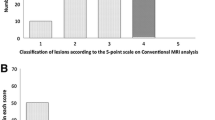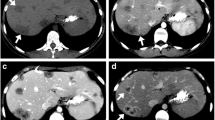Abstract
Purpose
To describe imaging findings in biphenotypic hepatic tumors (BPT) and a proposal for new imaging classification based on contrast-enhanced imaging.
Methods
Retrospective review of CT, MRI, PET/CT, and ultrasound findings in 39 patients with histologically confirmed BPT was performed. Tumor markers including AFP, L3 fraction, CA 19.9, CA 125, and CEA were recorded. Based on the dynamic enhancement features, BPT were categorized into 4 enhancement patterns (Types 1–4). Enhancement patterns were correlated with other imaging findings and tumor markers. Imaging features and tumor markers that were not consistent with diagnosis of hepatocellular carcinoma or intrahepatic cholangiocarcinoma based on enhancement pattern were considered discordant findings.
Results
Enhancement patterns in 29 patients (CT/MR) included 23 Type 2 (continuous peripheral rim of late arterial hyperenhancement with washout or fade in portal venous and/or delayed phases, ±delayed central enhancement) and 2 of each Types 1, 2, and 3. Discordant imaging findings were present in two patients with Type 2 pattern and in one patient with Type 1 pattern. Both AFP and CA 19.9 were elevated in 15 of 33 of patients. Tumor markers AFP and CA 19.9 were discordant in 17 of 21 patients with Type 2 pattern, two of two patients with Type 3 pattern. Most BPTs were markedly PET avid with average SUV max of 8.2. Most frequent ultrasound appearance is peripheral hypoechogenicity and central hyperechogenicity.
Conclusions
BPT most commonly present with imaging features similar to cholangiocarcinoma or metastases. BPT can be suggested when imaging findings or tumor markers are discordant with the most likely diagnosis based on enhancement pattern.








Similar content being viewed by others
References
Wells ML (1903) Primary carcinoma of the liver. Am J Med Sci 126(3):403–417
Allen RA, Lisa JR (1949) Combined liver cell and bile duct carcinoma. Am J Pathol 25(4):647–655
de Campos ROP, Semelka RC, Azevedo RM, et al. (2012) Combined hepatocellular carcinoma-cholangiocarcinoma: report of MR appearance in eleven patients. J Magn Reson Imaging 36(5):1139–1147
Goodman ZD, Ishak KG, Langloss JM, Sesterhenn IA, Rabin L (1985) Combined hepatocellular-cholangiocarcinoma. A histologic and immunohistochemical study. Cancer 55(1):124–135
Hwang J, Kim YK, Park MJ, et al. (2012) Differentiating combined hepatocellular and cholangiocarcinoma from mass-forming intrahepatic cholangiocarcinoma using gadoxetic acid-enhanced MRI. J Magn Reson Imaging 36(4):881–889
Jarnagin WR, Wever S, Tickoo SK, et al. (2002) Combined hepatocellular and cholangiocarcinoma. Cancer 94(7):2040–2046
Lee JH, Chung GE, Yu SJ, et al. (2011) Long-term prognosis of combined hepatocellular and cholangiocarcinoma after curative resection comparison with hepatocellular carcinoma and cholangiocarcinoma. J Clin Gastroenterol 45(1):69–75
Fowler KJ, Sheybani A, Parker RA, et al. (2013) Combined hepatocellular and cholangiocarcinoma (biphenotypic) tumors: imaging features and diagnostic accuracy of contrast-enhanced CT and MRI. Am J Roentgenol 201(2):332–339
Nishie A, Yoshimitsu K, Asayama Y, et al. (2005) Detection of combined hepatocellular and cholangiocarcinomas on enhanced CT: comparison with histologic findings. AJR Am J Roentgenol 184(4):1157–1162
Yin X, Zhang B-H, Qju S-J, et al. (2012) Combined hepatocellular carcinoma and cholangiocarcinoma: clinical features, treatment modalities, and prognosis. Ann Surg Oncol 19(9):2869–2876
Lin G, Toh CH, Wu RC, et al. (2007) Combined hepatocellular cholangiocarcinoma: prognostic factors investigated by computed tomography/magnetic resonance imaging. Int J Clin Pract 62(8):1199–1205
Zuo HQ, Yan LN, Zeng Y, et al. (2007) Clinicopathological characteristics of 15 patients with combined hepatocellular carcinoma and cholangiocarcinoma. Hepatobiliary Pancreat Dis Int 6(2):161–165
Razumilava N, Gores GJ (2014) Liver transplantation for intrahepatic cholangiocarcinoma—authors’ reply. Lancet 384(9949):1182–1183
Sapisochin G, Fidelman N, Roberts JP, Yao FY (2011) Mixed hepatocellular cholangiocarcinoma and intrahepatic cholangiocarcinoma in patients undergoing transplantation for hepatocellular carcinoma. Liver Transpl 17(8):934–942
Aoki K, Takayasu K, Kawano T, et al. (1993) Combined hepatocellular carcinoma and cholangiocarcinoma: clinical features and computed tomographic findings. Hepatology 18(5):1090–1095
Choi BI, Han JK, Kim YI, et al. (1994) Combined hepatocellular and cholangiocarcinoma of the liver: sonography, CT, angiography, and iodized-oil CT with pathologic correlation. Abdom Imaging 19(1):43–46
Fukukura Y, Taguchi J, Nakashima O, Wada Y, Kojiro M (1997) Combined hepatocellular and cholangiocarcinoma: correlation between CT findings and clinicopathological features. J Comput Assist Tomogr 21(1):52–58
Hashimoto T, Nakamura H, Hori S, et al. (1994) MR imaging of mixed hepatocellular and cholangiocellular carcinoma. Abdom Imaging 19(5):430–432
Bhagat V, Javle M, Yu J, et al. (2006) Combined hepatocholangiocarcinoma: case-series and review of literature. Int J Gastrointest Cancer 37(1):27–34
Danet IM, Semelka RC, Leonardou P, et al. (2003) Spectrum of MRI appearances of untreated metastases of the liver. AJR Am J Roentgenol 181(3):809–817
Ebied O, Federle MP, Blachar A, et al. (2003) Hepatocellular-cholangiocarcinoma: helical computed tomography findings in 30 patients. J Comput Assist Tomogr 27(2):117–124
Jeon TY, Kim SH, Lee WJ, Lim HK (2009) The value of gadobenate dimeglumine-enhanced hepatobiliary-phase MR imaging for the differentiation of scirrhous hepatocellular carcinoma and cholangiocarcinoma with or without hepatocellular carcinoma. Abdom Imaging 35(3):337–345
Panjala C, Senecal DL, Bridges MD, et al. (2010) The diagnostic conundrum and liver transplantation outcome for combined hepatocellular-cholangiocarcinoma. Am J Transplant 10(5):1263–1267
Saboo SS, Krajewski KM, Jagannathan JP, et al. (2011) Rapid progression of combined hepatocellular carcinoma and cholangiocarcinoma. Cancer Imaging 11(1):37–41
Sanada Y, Shiozaki S, Aoki H, et al. (2005) A clinical study of 11 cases of combined hepatocellular–cholangiocarcinoma. Assessment of enhancement patterns on dynamics computed tomography before resection. Hepatol Res 32(3):185–195
Shetty AS, Fowler KJ, Brunt EM, et al. (2014) Combined hepatocellular-cholangiocarcinoma: what the radiologist needs to know about biphenotypic liver carcinoma. Abdom Imaging 39(2):310–322
Shin CI, Lee JM, Kim SH, et al. (2007) Recurrence patterns of combined hepatocellular-cholangiocarcinoma on enhanced computed tomography. J Comput Assist Tomogr 31(1):109–115
Toh CH, Cheung YC, Ng SH, et al. (2004) Combined hepatocellular-cholangiocarcinoma: a case report. Int J Clin Pract 58(12):1170–1173
Theise ND, Nakashima O, Park Y, Nakanuma Y (2010) Combined hepatocellular-cholangiocarcinoma. In: Bosman FT, Carneiro F, Hruban RH, Theise ND (eds) WHO classification of tumours of the digestive system, 4th edn. Lyon: IARC Press, pp 225–227
Shiomi S, Sasaki N, Kawashima D, et al. (1999) Combined hepatocellular carcinoma and cholangiocarcinoma with high F-18 fluorodeoxyglucose positron emission tomographic uptake. Clin Nucl Med 24(5):370–371
Ijichi H, Shirabe K, Taketomi A, et al. (2013) Clinical usefulness of (18) F-fluorodeoxyglucose positron emission tomography/computed tomography for patients with primary liver cancer with special reference to rare histological types, hepatocellular carcinoma with sarcomatous change and combined hepatocellular and cholangiocarcinoma. Hepatol Res 43(5):481–487
Murakami T, Kim T, Tomoda K, et al. (1997) Combined hepatocellular and cholangiocellular carcinoma. Radiat Med 15(4):243–246
Nagaoka S, Itano K, Ishibashi M, et al. (2006) Value of fusing PET plus CT images in hepatocellular carcinoma and combined hepatocellular and cholangiocarcinoma patients with extrahepatic metastases: preliminary findings. Liver Int 26(7):781–788
Phongkitkarun S, Srisuwan T, Sornmayura P, Jatchavala J (2007) Combined hepatocellular and cholangiocarcinoma: CT findings with emphasis on multiphasic helical CT. J Med Assoc Thai 90(1):113–120
Schiettecatte A, Dujardin M, Beeck BOd, de Mey J (2008) Combined hepatocellular-cholangiocarcinoma: MR findings. Eur J Radiol Extra 67:75–77
Willekens I, Hoorens A, Geers C, et al. (2009) Combined hepatocellular and cholangiocellular carcinoma presenting with radiological characteristics of focal nodular hyperplasia. World J Gastroenterol 15(31):3940–3943
American College of Radiology (2013) Liver Imaging Reporting and Data System in version 2013.1. Reston: American College of Radiology
Chung YE, Kim MJ, Park YN, et al. (2009) Varying appearances of cholangiocarcinoma: radiologic-pathologic correlation. Radiographics 29(3):683–700
Hussain SM, Semelka RC, Mitchell DG (2002) MR imaging of hepatocellular carcinoma. Magn Reson Imaging Clin N Am 10(1):31–52, v
Bruix J, Sherman M (2011) Management of hepatocellular carcinoma: an update. Hepatology 53(3):1020–1022
Page AJ, Cosgrove DC, Philosophe B, Pawlik TM (2014) Hepatocellular carcinoma: diagnosis, management, and prognosis. Surg Oncol Clin N Am 23(2):289–311
Khan SA, Davidson BR, Goldin RD, et al. (2012) Guidelines for the diagnosis and treatment of cholangiocarcinoma: an update. Gut 61(12):1657–1669
Cheung TT, Ho CL, Lo CM, et al. (2013) 11C-Acetate and 18F-FDG PET/CT for clinical staging and selection of patients with hepatocellular carcinoma for liver transplantation on the basis of milan criteria: surgeon’s perspective. J Nucl Med 54(2):192–200
Sacks A, Peller PJ, Surasi DS, et al. (2011) Value of PET/CT in the management of primary hepatobiliary tumors, Part 2. Am J Roentgenol 197(2):W260–W265
Lam MGEH, Kwee TC, Basu S, Alavi A (2013) Underestimated role of 18F-FDG PET for HCC evaluation and promise of 18F-FDG PET/MR imaging in this setting. J Nucl Med 54(8):1510–1511
Yeh MM (2010) Pathology of combined hepatocellular-cholangiocarcinoma. J Gastroenterol Hepatol 25(9):1485–1492
Ayuso J-R, Pagés M, Darnell A (2013) Imaging bile duct tumors: staging. Abdom Imaging 38(5):1071–1081
Lee CH, Hsieh SY, Chang CJ, Lin YJ (2013) Comparison of clinical characteristics of combined hepatocellular-cholangiocarcinoma and other primary liver cancers. J Gastroenterol Hepatol 28(1):122–127
Forner A, Rodríguez-Lopez C, Reig M (2012) Natural history and staging for hepatocellular carcinoma. Clin Liver Dis 1(6):183–185
Kassahun WT, Hauss J (2008) Management of combined hepatocellular and cholangiocarcinoma. Int J Clin Pract 62(8):1271–1278
Brown DB, Gonsalves CF (2008) Percutaneous biopsy before interventional oncologic therapy: current status. J Vasc Interv Radiol 19(7):973–979
Robertson EG, Baxter G (2011) Tumour seeding following percutaneous needle biopsy: the real story!. Clin Radiol 66(11):1007–1014
Author information
Authors and Affiliations
Corresponding author
Rights and permissions
About this article
Cite this article
Wells, M.L., Venkatesh, S.K., Chandan, V.S. et al. Biphenotypic hepatic tumors: imaging findings and review of literature. Abdom Imaging 40, 2293–2305 (2015). https://doi.org/10.1007/s00261-015-0433-9
Published:
Issue Date:
DOI: https://doi.org/10.1007/s00261-015-0433-9




